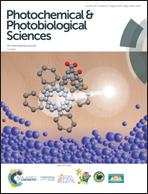Influence of the auxiliary acceptor and π-bridge in triarylamine dyes on dye-sensitized solar cells
Abstract
Four metal-free organic dyes (AFL7–AFL10) based on triarylamine donors and different π-bridges with or without a benzothiadiazole auxiliary acceptor have been synthesized. The dyes’ photophysical and electrochemical properties, theoretical calculations, and dye-sensitized solar cell (DSSC) performances have been investigated. Electrochemical measurement data indicate that varying the π-conjugacy system can tune the HOMO and LUMO energy levels. A high molar extinction coefficient combined with a broad absorption spectrum helps to reinforce the dyes’ light harvesting ability; therefore, it could help to increase the JSC of the DSSCs. Among the four dyes, AFL7 bearing the bithiophene bridge achieves the best photocurrent performance with a JSC value of 16.94 mA cm−2, corresponding to an overall conversion efficiency η of 7.92% under standard AM 1.5 G conditions (that of N719 dye was 8.53% under the same conditions). The results show that the dyes based on the triarylamine donor containing fluorenyl and biphenyl moieties are promising candidates for improving the performance of DSSCs.



 Please wait while we load your content...
Please wait while we load your content...